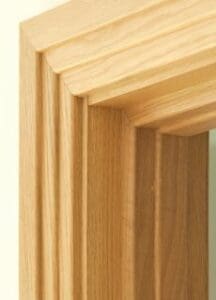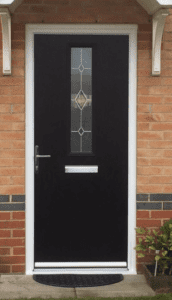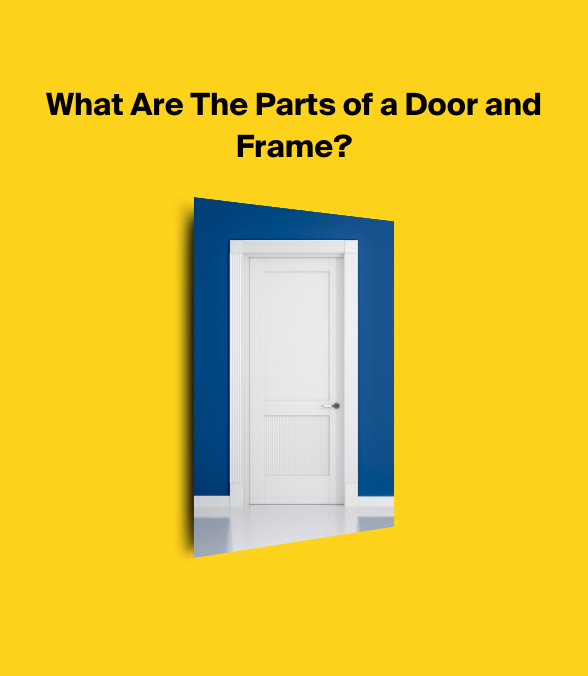What are the main parts of a door and frame called?
To most people, getting a new door is just choosing the style and colour they like and a good lock to keep pesky burglars out.

You may just know them as a front door, back door or side door. However, when you get into it, doors are an essential part of every building providing security, privacy, and access control.
While they may seem like a simple fixture, a door consists of many interconnected parts that work together to provide functionality and security.
We really love doors at Value Doors!
So, in this article, we will take a closer look at the main parts of a door and frame, their functions, and how they work together to keep you safe and secure.
If you're looking for a new door fitting, then you can fully design one online now at a fixed price, including full expert installation.
What makes a door and frame?
A door is more than just a slab of wood or metal that swings open and closed. It's a complex mechanism that consists of several interconnected parts that work together to provide security, privacy, and functionality.
Understanding the different parts of a door and frame is essential, whether you are replacing a damaged door or installing a new one. Door hardware is also becoming more popular with more stylish designs and extra security features.
Parts of a door list
The basic parts of a typical door include:
- Door leaf/panel: This is the main part of the door that opens and closes.
- Door Frame: The frame provides support for the door and helps it stay in place.
- Door Jamb: The jamb is the vertical part of the door frame, against which the door closes.
- Door Hinges: These are the mechanisms that allow the door to swing open and closed.
- Lockset: The lockset includes the doorknob, latch, and lock mechanism, which keeps the door securely closed.
- Strike plate: This is a metal plate that is attached to the door frame and receives the latch or bolt from the lockset.
- Door Threshold: The threshold is the horizontal strip that runs across the bottom parts of a doorway.
- Weatherstripping: This is a material that is used to seal the gap between the door and the frame, preventing air and moisture from entering.
- Doorstop: This is a small piece of hardware that prevents the door from swinging too far in one direction.
All these are the most common part names for a doorway, there are slight variations usually from different countries such as the UK and the USA which are detailed below too.
The Anatomy of a Door Explained
Door Leaf or Door Panel
The door leaf is part of the door that swings open and closed. It can be made of wood, metal, glass, or a combination of these materials. The door leaf may have a hollow or solid core, and its thickness can vary depending on the door's intended use.
Often referred to as the door panel or slab, opting for a solid timber core GRP composite door is much more secure than foam-filled uPVC door panels. While the price may be higher for these door parts, the cost could be higher if intruders can easily break in.
Read more here about the standard door sizes in the UK for more information.
Door Frame
The door frame is the structural component that surrounds the door leaf and supports it. It is usually made of wood or metal and consists of three parts: the jamb, head, and sill.
The door frame is designed to fit snugly around the door leaf and provide a secure and stable mounting surface for the hinges and lockset.
Door Hinges
Door hinges are the mechanical components that allow the door leaf to swing open and closed. There are many different types of door hinges in the UK. They attach to the door leaf and the door frame and are available in different sizes, styles, and finishes.
The number of hinges needed depends on the door's size and weight. Hinges dropping is often one of the most common door problems that need to be fixed, especially just after installation.
Handle
Whilst not all doors have a handle, more often than not there will be some sort of catch or lever to push, pull, turn or lift.
Doors are there to be opened, so a door handle or opener is arguably one of the most important parts of a door. Otherwise, it's simply just part of the wall.
For exterior doors, you can even get super secure handles that are designed to hinder burglary attempts as much as possible along with a super secure locking mechanism.
Sometimes, door handles can develop issues over poor installation or too much use, such as being too loose. Knowing how to fix a door handle will help save you money in terms of having get hire a professional to repair it for you.
Lockset
The lockset is the mechanism that secures the door in a closed position. On the standard door, it consists of several components, including the latch, deadbolt, and strike plate.
In recent times, though, security has seriously improved.
With the likes of Ultion creating extremely secure locks and external door manufacturers such as Comp Door inventing much better mechanisms within the door panel, so there are fewer problems with composite door locks.
Locksets are available in different styles and finishes, and in the UK you can even get a remote locking mechanism that will come with advanced security features such as electronic keypads or biometric scanners for your home.
Weatherstripping
Mainly for external doors, weather stripping is a sealing component that prevents air, water, or insects from entering the building around the door. It is usually made of rubber or foam and is applied to the door frame or the door leaf.
Threshold
The door threshold is the horizontal component that forms the bottom of the door frame between the two door jambs.
A door threshold provides a smooth transition between the interior and exterior flooring and helps prevent drafts, water, or insects from entering the building.
Glazing
Glazing is one of the parts of a door that is not necessary but is still important if required. You can get single glass panes, double glazing, or even triple glazing in doors to increase security and energy efficiency.
The glass can also be styled with colour, opacity, leading, and texture to suit your design and home. Putting glass in doors usually makes them more expensive.
Knocker
Knock Knock, who's there? A knocker, again, is not an essential part of a door but is of use, and there are many various designs and styles out there to bring your door to life.
Fitting a door knocker to front doors is relatively easy, and nowadays, in the UK, you can get door knockers that can be fitted without screwing into the door.
Door bar
For extra security, some people like to have a door bar. This is a piece of metal that is attached to the door jamb, that slots over another piece of metal on your door.
If your door is opened, the door bar will engage and only let your door be opened so far until it locks. This enables the homeowner to have the door open but it is still secure.
Letterplate
Delivery! The letter plate or letter box is just an opening for the postman to be able to post your letters built into your front door. There is a range of different styles, shapes and sizes available depending on your requirements.
Numbers
Most people like to make it easy for people to find their home (or maybe not for the recluses); therefore, there is a wide range of colours, styles and letters, all to match the design of most homes in the UK.
Spyhole
One for people who like to see who it is before answering the door, the spy hole or peephole can be fitted to most doors in the UK for extra security. With Ring Doorbells on the rise, spy holes are likely to become fewer and fewer.
Escutcheon
You've probable seen plenty of these but never know what they are called, an escutcheon is a decorative or protective plate or shield that is typically mounted on a wall or door to cover a keyhole, lock mechanism, or other similar feature.
It's often made of metal or another durable material and can be ornately designed to add a touch of elegance to the door or object it covers.
Door Closer
A door closer is a hydraulic or pneumatic device fitted above the door header that automatically closes the door after it has been opened.
You'll very rarely see one of these in a house in the UK as a door closer is commonly used in commercial or public buildings to ensure that doors are always closed, reducing the risk of theft, unauthorised access, or fire.
Door Frame Parts
Two of the most crucial door frame components are the door jamb and the door frame. Despite their importance, many people are confused about the difference between the two.
A door frame is a structural component that provides support and stability to the door. It is the framework onto which the door is mounted, and it is what keeps the door in place.
The frame is usually made of wood, metal, or PVC, and it can come pre-assembled or be built on-site. The frame consists of several parts, including:
Door jamb
The door jamb is basically the part of the frame that the door leaf is attached to. However, there are more specific parts to the frame that we will look at in more detail so you know exactly which bit we are talking about and why they are important.
If you are looking for more information on door jamb sizes and widths, read our guide for how to measure up!
The Head Jamb
If you are over 6 foot 4 tall then this is likely the part that you have banged your head on.
The header jamb is the horizontal piece that spans the top of the door frame, often attached to a door lintel.
It's typically made of a solid piece of lumber, such as a 2x4 or 2x6. The purpose of the header is to distribute the weight of the structure above the door evenly across the side jambs.
The Side Jambs
The side jambs are the vertical pieces that form the sides of the door frame. They are typically made of solid lumber and are attached to the header and the threshold. The side jambs hold the weight of the door and ensure that it fits snugly within the frame.
Strike plates are usually fit to one of the side jambs for the locking mechanism to fit into; therefore, when fitting door parts, this needs to be secure.
Cill
"What is the piece of wood at the bottom of a door called?" Well, that would be a cill. The door cill or door sill, depending on how you prefer to spell it, is part of the bottom part of the door frame that runs across the floor.
This is a protector and finish that hides unsightly parts of the door frame where it is joined to the floor and provides a lip to protect the threshold.
Other Door Frame Components
In addition to the header, side jambs, and threshold, there are several other components that make up a door frame. These include:
Casing
The casing is the decorative trim that covers the gap between the door frame and the wall. It can be made of wood, PVC, or other materials and comes in a variety of styles and finishes.
Hinges
Hinges are the hardware that attaches the door to the frame. They are typically mounted on the side jamb and allow the door to swing open and close.
Strike Plate
The strike plate is the metal plate that is mounted to the side jamb opposite the hinges. It serves as a receptacle for the door latch or bolt and helps to keep the door securely closed.
What Is the Difference Between a Door Jamb and a Door Frame?
Now that we have a better understanding of what a door jamb and door frame are let's examine the differences between the two.
- A door frame is a complete unit that consists of a head, jambs, and sill, while a door jamb is just the vertical portion of the frame that holds the hinges and latch.
- The frame is usually installed before the door is hung, while the jamb is installed on the wall first, and then the door is attached to it.
- The frame provides support and stability to the door, while the jamb only serves as a point of attachment for the door.
In summary, the door frame is the complete structure that holds the door in place, while the door jamb is the vertical part of the frame that holds the hinges and latch.
The frame is installed before the door, while the jamb is installed on the wall first and then attached to the door.
Door Frames Conclusion
In conclusion, a door frame is an essential component of any door. Understanding the different parts of a door frame and their functions can help you choose the right type of door frame for your needs.
Whether you're building a new home or replacing an existing door, a well-constructed door frame is essential to ensuring the longevity and functionality of your door.

FAQs
Can you replace a door jamb without replacing the entire door frame?
Yes, it is possible to replace a door jamb without replacing the entire door frame. However, it is essential to ensure that the new jamb is compatible with the existing frame.
Can you replace a door frame without replacing the entire door?
Yes, it is possible to replace a door frame without replacing the entire door. However, it is essential to ensure that the new frame is compatible with the existing door.









